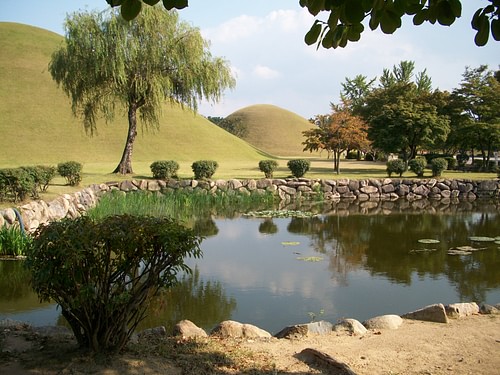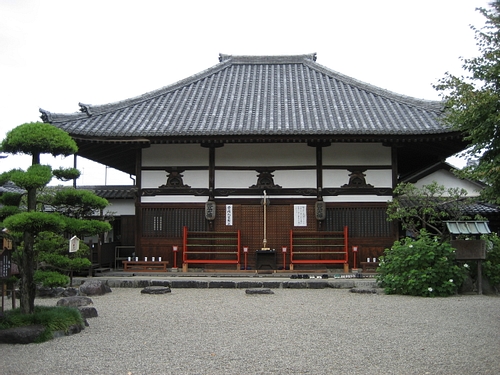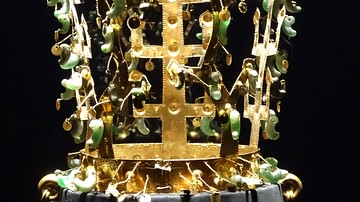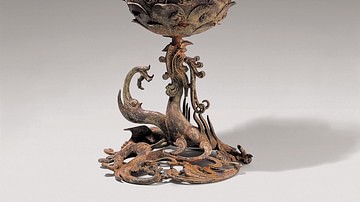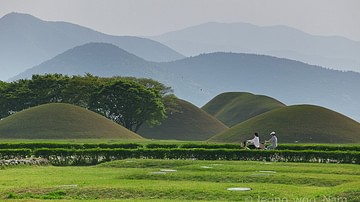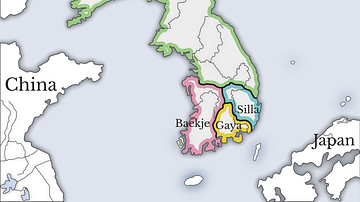Ancient East Asia was dominated by the three states known today as China, Japan, and Korea. The complex chain of successive kingdoms created a rich web of events that archaeologists have sometimes found difficult to disentangle; a situation not helped by modern nationalist claims and ideals superimposed on antiquity from all three parties.
In this interview, James Blake Wiener of Ancient History Encyclopedia (AHE) speaks to Prof. Gina L. Barnes, Professorial Research Associate in the Department of Art & Archaeology at SOAS University of London, about the ancient interactions between the Korean Peninsula and the Japanese archipelago.
JBW: Prof. Gina L. Barnes, welcome to Ancient History Encyclopedia and thank you for speaking with me about a tricky but very intriguing subject: Korean-Japanese relations through the prism of archaeology and ancient history.
I wanted to begin our interview by asking why ancient Korean-Japanese relations are of supreme importance to historians and archaeologists in East Asia?
GLB: Thank you, James, for inviting me to talk about ancient Korean-Japanese relations as seen from archaeology. This is indeed a sensitive topic, given the more recent animosity between the countries over the annexation of Korea by Japan in 1910 CE and its governance as part of the Japanese Empire until 1945 CE. There is also the lingering resentment of Hideyoshi's push to conquer China in the late 16th century CE. He decimated south and central Korea trying to get to the Chinese capital, causing the people of Gyeongju (Kyongju) to take refuge near the grand tombs of the Silla kings.
These events make it all the more important to look back further in history to see that the relations between the Korea and Japan were not always hostile. In fact, what we see from the material record and the documentary evidence is that there were eras of very close and friendly relationships and that much of Japan's early material culture derived from Korea.
JBW: How do you approach this complex topic as an archaeologist?
GLB: The first step is to do away with modern national boundaries. I have resorted to geographical referents: the Korean Peninsula and the Japanese Islands. This is all the more imperative when it is realized that even in the early period of state formation, there were three, possibly four, early states occupying the Korean Peninsula; Goguryeo (Koguryŏ), Silla, Baekje (Paekche), and later Gaya (Kaya). The early Japanese state (Yamato) did not exceed the Kansai region (around modern Kyoto, Nara and Osaka), with alliances to the west and hostile relations with indigenous peoples to the northeast within the Japanese Islands. Thus, it is important to acknowledge that the modern states represent the current time slice and cannot be telescoped back into deep history. State boundaries have continuously changed throughout the last 1500 years, and there is no reason to assume they will remain static into the future. And before states, people could come and go and were not restricted by political boundaries or national identities.
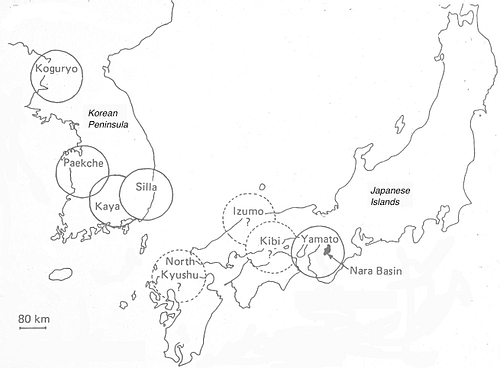
The second step is to realize that the Korean Peninsula and Japanese Islands share a developmental trajectory that contrasts to the earlier emergence of states on the China Mainland. I have coined the geographical term “Pen/Insulae” to refer to this joint heritage (and avoid modern state names), and I use the “China Mainland” to avoid references to modern China. States developed on the China Mainland in the 2nd millennium BCE, with the Han Dynasty exerting particular influence on the Pen/Insulae between the 1st and 3rd centuries CE. It was after the collapse of this dynasty and its successor, the Wei Dynasty, that early states in the Pen/Insulae began to emerge as strong players in East Asia – with similar timing in the 3rd–5th centuries CE, somewhat along the lines of the rise of the Anglo-Saxon kingdoms in Britain after the fall of Rome. There was much interaction within the Pen/Insulae that led to shared cultural traditions.
JBW: Is it fair to say that Korea acted as a “cultural bridge” between China and Japan? How problematic is this term in your opinion, Professor Barnes?
GLB: The term “cultural bridge,” although well-meaning, is both derogatory and misleading. Yes, many cultural developments reached the Japanese Islands through the intermediary of the Korean Peninsula, but some were from indigenous peninsular cultures and others directly from the Chinese military outposts on the Korean Peninsula. Moreover, the idea of a “bridge” makes it sound like everything arrived undiluted or unchanged from the China Mainland and that nothing was transformed in the process.
For example, saying that Buddhism was transferred from China to Japan via Korea, it could equally well be misstated that Buddhism was transferred from India to Korea via China. No one thinks of China as being a "cultural bridge". When travel is limited to progress on land (not sea), which takes time to traverse space, cultural developments are inherently transformed, becoming localized in the process; if these developments are shared onwards, they bear the cultural stamp of the intermediary stops. The risk in referring to the Korean Peninsula as a “cultural bridge” is failing to acknowledge how transforming those new elements might have been for Korean culture (broadly speaking), regardless of whether the phenomenon was passed further on.
Between the 3rd and 6th centuries CE, we know that Indian monks traveled to both China and Korea, disseminating their teachings directly, and monks from the Korean Peninsula traveled to India or just to China to study under Indian monks there. Indian monks also reached the Japanese Islands, and monks from there traveled to China to study under Indian monks or Chinese monks who had studied in India. The idea that the Korean Peninsula was a “cultural bridge” to the Japanese Islands is far too simplistic and does not take into account the special relationship between Baekje (not the whole Peninsula) and Yamato (not the entire Islands) as discussed below.
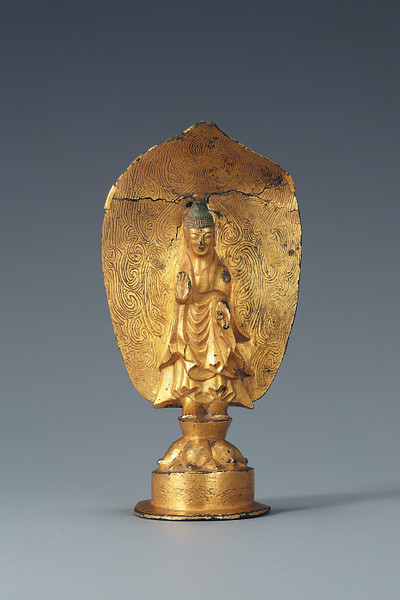
JBW: Would it be accurate to say that relations between Korea and Japan alternated between friendly trade partnerships, periodic alliances, and outright hostilities in the ancient and medieval periods?
GLB: Pen/Insular exchange relations began between groups of hunter-gatherers around 5000 BCE; in the Jomon period (14500–400 BCE), obsidian from Mt. Aso in Kyushu was traded into the Korean Peninsula, and Jomon pottery is found in southern Peninsular sites. Agricultural practices from the China Mainland were introduced into the Korean Peninsula; millet from the northeast sometime before 3500 BCE and wet-rice from the southeast at around 1500 BCE. These were together taken by Peninsular Bronze Age migrants into the Japanese Islands at the beginning of the 1st millennium BCE. Around 300 BCE, bronze and iron were both introduced into the Japanese Islands via Bronze Age contacts. All these interactions were ostensibly friendly, cooperative, and productive.
In 108 BCE, the Han Dynasty of China established the Lelang military commandery on the northern Korean Peninsula, near today's Pyongyang, in the vicinity of Gojoseon (Kochosŏn). The iron resources of the southern Peninsular coast were extracted for Chinese use and the southern iron smelters also supplied the surrounding peoples with this strategic material. The development of the Yamato state in the 3rd–5th centuries CE was underwritten by Peninsular iron. When this resource was threatened by the predations of the Goguryeo state southwards in the late 4th century CE, Yamato entered an alliance with the emerging state of Baekje to protect those resources. Even in the late 4th century CE, it is impossible to say that that pendulum had swung towards hostilities because Yamato and Goguryeo were enemies but Yamato and Paekche were allies. There was no Korea/Japan divide. 
Here, I would like to say a word about Mimana, which has appeared in English-language histories of Japan as a 4th-century CE colony on the Korean Peninsula. This view derives from the nationalistic reading of the 8th-century CE Nihon Shoki chronicles by 19th-century CE Japanese imperialists during the restoration of the emperor and who later misused the text to argue for the annexation of the Korean Peninsula in 1910 CE. Textual scholars today from both South Korea and Japan agree that there was a facility on the southern Korean Peninsula during the 6th century CE - not the 4th century CE - that was manned by Japanese of Peninsular descent and others to regulate the iron industry in trading with the surrounding countries reliant on its resources. This was not an administrative colony nor a military outpost but an economic “port of trade.”
The Baekje–Yamato alliance resulted in the second wave of immigration from the southern Peninsula from the late 4th through the 7th centuries CE; this time, however, the refugees from the Peninsular warfare constituted groups from both Baekje and Gaya of craftspeople making elite goods, members of aristocratic families, and learned individuals who brought writing and Buddhism to the Yamato Court. The 9th-century CE document, Shinsen Shoji Roku, identified one-third of early Heian period aristocratic families having Peninsular roots – a fact conveniently forgotten in today's Japan. The relations between Yamato and Silla also shifted back and forth from hostile to friendly relations so that, again, generalization about Korea–Japan relations at this time is impossible.
The pendulum indeed began to shift with Hideyoshi's invasions of 1592 and 1597 CE when he sacked the capital of Gyeongju. The military devastation was exacerbated by the forced migration of many porcelain potters from the southern Peninsula to northern Kyushu, essentially setting up a ceramic industry to produce tea ceremony wares for the Shogun. South Korean porcelain manufacturing has only recovered since the Pacific War (World War II). The rapaciousness of Hideyoshi's raids was only compounded by the 1910 CE annexation of Korea, forcing “citizens” to forsake their own culture and language by attending Japanese schools. And of course, there is the most recent abuse of “Comfort Women” during World War II (1937-1945 CE), forcing many Korean women to service Japanese soldiers throughout the empire.

JBW: Gina, the kingdom of Baekje established trade and cultural ties with Japan during the Asuka Period (538-710 CE). What circumstances led the Japanese to be so receptive to Korean and Chinese culture at this particular time in history?
Additionally, why were successive Korean kingdoms willing to share their know-how and expertise with the Japanese over the centuries?
GLB: The Yamato–Baekje alliance was in the interest of both parties, and because Yamato was further away from Gogureyo, it was a destination for refuge of Peninsular peoples under threat of attack. The advances of Peninsular culture, which substantially resulted from being closer to the China Mainland and in direct contact with Chinese courts and commanderies, developed under conditions of both sharing and duress. When these advancements were made available to the Yamato court, in particular, the new objects and behaviors were welcomed as status symbols and new technologies.

JBW: In your opinion, what were the three most important innovations or cultural contributions that came to Japan by way of the Korean peninsula?
GLB: Writing, Buddhism, Confucianism. Not that all these were entirely good. Chinese writing is poorly suited for representing Japanese or Korean. These belong to an entirely different language family than the Chinese languages, having inflected verbs and adjectives that cannot be represented by monosyllabic or even bisyllabic character combinations. To write native Japanese words more accurately, a syllabary was developed the 9th century CE, ostensibly by the priest Kukai; in Korea, a similar syllabary was invented in the mid-15th century CE under King Sejong. Early modern materials were thus all written in combinations of characters and syllabary. With enough Chinese characters in a text, if you knew one language, you could begin to make sense of the other two. However, the South Korean government ended the use of characters formally in 1970 CE, and they have gradually disappeared from public writing. By the 1990s CE many young academics wrote only in Hangul syllabary. This makes it impossible to understand written Korean unless you know the language well – another nail in the coffin, preventing shared information.
The arrival of Buddhism in the mid-6th century CE stimulated the florescence of a whole arena of historic Japanese culture. It also stimulated the development of native beliefs into a complementary religion expressed in shrines rather than temples. This developed into State Shinto which underwrote the Pacific War effort. This is not to blame Buddhism, but it is an interesting thought how Japanese culture would have developed without Buddhism and without native beliefs being on the defensive.
Confucianism was allegedly introduced into the Yamato Court by a Baekje scholar in the early 5th century CE and was subsequently represented in the Seventeen Article Constitution promulgated by the Regent Shotoku Taishi in 604 CE. Accepted into 7th-century CE Yamato, Confucianism transformed the Court system into a patrilineal, patriarchal endeavor. By the Nara period (710–794 CE), the age of strong women rulers such as we see recorded in the Nihon Shoki was over; today female inheritance of emperorship is forbidden by law. How would Japan have developed without these Chinese influences? Indeed, how would Korea have developed without the same patriarchal Confucian tendencies? The Silla queens, partaking of the Sacred Bone rank, could exercise monarchical rights (and rites) equally with their male kin. But an increasingly Confucian orientation of the court there as well led to the exclusion of women from rulership. If either Korea or Japan had escaped Confucian influences, they would have grown into very different historical societies.
JBW: You are a specialist in both Korean and Japanese archaeology. I am curious to know what are the current challenges facing your field. Could you perhaps elaborate what these are based on a reflection of your own experience?
GLB: We must resist attempts at nationalistic interpretations of history, especially the tendency to use archaeological and historical data to argue ethnic superiority. There are now cases where right-wing factions in the national governments are interfering with academic research funding and institutional structures for their own purposes. Academia must be an endeavor free from political interference. Even the designation of important cultural properties by UNESCO has become a competition of sorts between national governments to claim archaeological resources within their current boundaries as part of their exclusive ethnic histories. What we need is “archaeology without boundaries” to represent the diverse range of cultures and peoples that preceded us and accord them respect in their own right.
JBW: Do you detect any growing interest in ancient Korean-Japanese relations within academia, Professor Barnes?
GLB: Canada has lost its two archaeologists of Japan through retirement, replaced by two China scholars. In the United States, there is only one doctoral program for Japanese archaeology while two other major archaeologists of Korea and Japan are retired; in the UK, there are none teaching in full-time posts. My young colleagues in Europe cannot obtain permanent positions, with most posts going to China scholars. I cannot say that academic inquiry into early Korea–Japan relations is increasing.
JBW: On that note, which topics, in particular, do you hope scholars and researchers explore more in depth in the future?
GLB: We need a thorough re-evaluation of the Nihon Shoki and retranslation into modern English. We need far more publications from local scholars in English, which requires bringing Korean and Japanese scholars out of their shells into the international network. These are closed academic circles where status and promotion rely entirely on internal activities, not international reputation. How can we convince them that it is in their interests to get their work known and Korean and Japanese archaeology better understood outside East Asia?
Despite trying to take a regional approach to examine East Asian development, the problem in doing archaeology is that all information is organized by modern state and language. There is very little communication among archaeologists of the East Asian countries and even less with their world counterparts. The language barrier is alive and healthy in this area, and it is particularly significant since a tremendous amount of archaeology has been carried out locally for the last 100–150 years that remains inaccessible to the West. This contrasts with archaeology in many other countries of the world that have experienced colonial archaeology by Western-language researchers or modern archaeological expeditions from Western institutions. These make the archaeological resources of those countries known to the West in a way that East Asian archaeology is not. Thus, we need far more interaction among scholars, translation of local advances, joint projects, more publication in English, and more Western archaeologists competent in East Asian languages.
JBW: Gina, thanks so much for your time and consideration! I wish you many happy adventures in research.
GLB: Thank you for the opportunity to air some of the issues surrounding scholarship on early Japan–Korea relations. I believe in social engineering the pendulum to swing back to friendly relations as we saw up into mid-1st millennium CE. While understanding the negative elements, let us look to the future concentrating on the positive elements.
Prof. Gina L. Barnes, a California native raised in Colorado, has spent her working life in England, finishing her Ph.D. on Japanese state formation for the University of Michigan (1983) while teaching East Asian archaeology as Assistant Lecturer in the Department of Archaeology, University of Cambridge (1981-85). She worked briefly at the University of Leiden (1986), where she expanded her interests in Korean state formation, then returned to St. John's College, Cambridge, as a Senior Researcher (1987-95). In 1996, she took up the post of Professor of Japanese Studies at Durham University, from which she retired as Emeritus Professor in 2006. In 1990, she founded the East Asian Archaeology Network, which became the Society for East Asian Archaeology in 1996. She served as first President (1996-1998), Treasurer & Membership Secretary (2004-2012), and organized the first two SEAA Worldwide Conferences in Honolulu (1996) and Durham (2000). In 2012 she collected a BSc in Geosciences (Geology) from the Open University and is now a Fellow of the Geological Society of London. She is an affiliate of the Earth Sciences Department of Durham University and holds Professorial Research Associateships at SOAS University of London in the Japan Research Centre and Department of History of Art & Archaeology. She currently teaches about Korean and Japanese archaeology in the SOAS Diploma in Asian Art and the MA course “Archaeologies of Asia” at University College London. Her major book is Archaeology of East Asia: the rise of civilization in China, Korea and Japan (Oxbow Books, 2015).
This content was made possible with generous support from the Great Britain Sasakawa Foundation.

